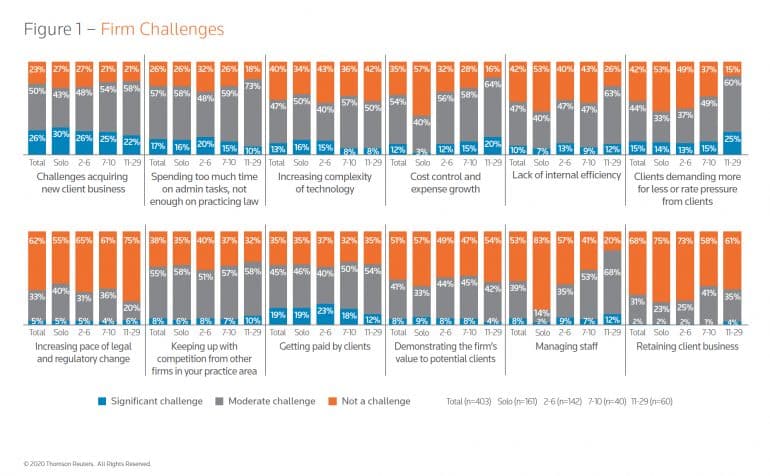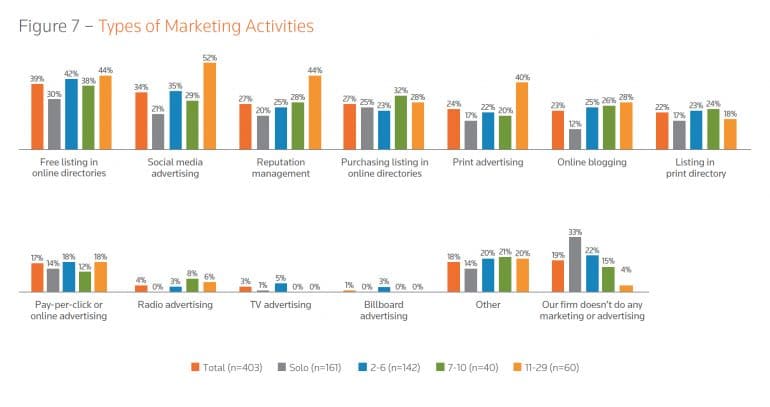Most small law firms consider themselves successful, says Thomson Reuters’ 2020 State of U.S. Small Law Firms report. Nonetheless, these firms continue to face challenges in getting and keeping new clients. They also spend too much time on administrative tasks and not enough time practicing law.
The report, released today, is based on interviews conducted in April and May with more than 400 solo and small firm lawyers and is the fourth such report produced by Thomson Reuters.
Takeaways from the Small Law Firm Survey
The 2020 State of U.S. Small Law Firms asked small firms about their biggest challenges and how they’ve addressed them, as well as their goals and priorities, how they measure success, key performance factors, and future spending plans. Related deeper dives into marketing tactics and the state of small firm technology use round out the report. Responses are broken down by firm size, from solo practices to firms up to 29 lawyers.
The upside is that not much has changed — at least as of May. The basic challenges — finding work and then finding time to do it — remain the same as in past versions of the report. The downside? Not much has changed in response, either.
Here are the three main takeaways highlighted in the report:
- Small law firms continue to face a number of significant challenges — many of which have remained consistent year-to-year. The most frequently cited challenge is acquiring new client business. This is followed closely by spending too much time on administrative tasks and not enough time practicing law.
- Despite facing many of the same challenges one year to the next, most small law firms have yet to take meaningful action to deal with the problem.
- Because of a general lack of action, there is a real opportunity for those firms willing to make the first move. While some small law firms have already taken a leading role to innovate their service delivery models, there remains ample fertile ground for other firms to implement similar changes, whether by improving business development acumen, creating optimal internal efficiencies for managing their law firms, or adopting technology to streamline their practice.
“Small firm lawyers have unique challenges, as they are oftentimes not only lawyers but also small business owners and managers in running their practices,” said Mark Haddad, general manager of the Thomson Reuters Legal’s Small Law Firm business. “Juggling those roles reduces the amount of time spent practicing law. At the same time, the lack of action by many firms in addressing those challenges means opportunities for competing firms to gain ‘first mover’ advantage.”
A few other key findings:
- Small firms felt increasing pressure around getting paid by clients, especially firms with 10 or fewer attorneys — and this is the challenge they are most likely to have taken steps to address.
- For most, the bulk of the pressure they feel from competition comes from other law firms, as opposed to DIY legal websites or alternative legal service providers.
Challenges Remain the Same
Among the small firms in the report, 95% consider themselves either “successful” or “very successful.” Looking at solos specifically, that figure stays pretty consistent, at 92%. But as noted, at the same time, most of the firms continue to face significant challenges.
For 76%, acquiring new client business is a significant or moderate challenge (26% of respondents rated this a significant challenge). A similar percentage (74%) say the same about spending too much time on administrative tasks instead of practicing law. (17% of respondents rated this a significant challenge). As a result of management and administrative burdens, the study found that small firm lawyers, on average, spend only 60% of their time doing client work.
One in five small firms (19%) say getting paid by clients is now a significant challenge, up from 14% in the previous survey. The report notes this could be a result of pressure on firms stemming from the COVID-19 outbreak, as well as lack of financial back-end and payment systems at many firms.
So, what have small firms been doing to address their challenges, and what are they planning to do?
- Only 29% of firms have actually implemented plans to address client acquisition. An even smaller number — 20% — have implemented plans to reduce their administrative workload.
- Among firms that have implemented a plan — or have at least have a plan —approximately 25% pointed to changing technology. Other cited changes included increasing, updating or emphasizing marketing; monitoring or cutting costs such as salaries or overhead expenses, and improving collections.
That’s not to say firms are doing nothing to adapt or grow — even if those changes are not directly related to the challenges they identified. When asked about changes made to the firm, more than half report increasing their billing rates, a traditional go-to strategy. Far fewer report changing billing practices to offer more alternative fee arrangements. Technology was a dominant theme here as well, with 45% of respondents adopting new technology in the past two years. Less common, though still noteworthy, 25% of respondents reported cutting ties with unprofitable services or clients, and 23% reported changing their marketing strategy, an important step to address that much-discussed challenge.
Why make these changes? Reducing costs and improving the quality of services were the two top answers. Improving efficiency, despite ranking as a top challenge, barely registered as a reason for a change.
State of Small Law Firm Technology
Not surprisingly, technology remains a top spending priority for small law firms. The report says 30% plan to increase their investment in technology and infrastructure. However, in keeping with the theme, these firms aren’t necessarily investing in areas that would address major challenges, such as acquiring clients and reducing administrative burdens. According to the report, “Their planned investments are primarily in technologies such as case management, document management, and electronic signatures, rather than front- and back-office functions such as financial management and accounting, or client-intake software.”
So what types of technology are small firms currently using? The top items are:
| Time and Billing | 74% | Document or Forms Assembly/Automation | 25% |
| Financial Management/Accounting | 52% | Practice Management | 25% |
| Document Management | 47% | Rules-based Docket/Calendaring | 25% |
| Conflict Checking | 46% | Litigation Support | 24% |
| Electronic Signatures | 40% | eDiscovery | 23% |
| Case/Matter Management | 39% | Matter Budgeting and Cost Tracking | 14% |
| eBilling | 36% | Client Portals or Data Rooms | 12% |
| Document Drafting Tools | 31% | CRM or Contact Management | 12% |
| Client Intake | 25% |
In addition, the report says that internal portals, custom applications, collaboration tools, knowledge management tools, and legal project management tools are used by 10% or less of the responding firms.
State of Small Law Firm Marketing
It’s always eye-opening to see how your colleagues choose to invest their marketing efforts and budget, and the 2020 State of U.S. Small Law Firms breaks down usage of more than a dozen tools and tactics. Free online directories comes out on top at 39%, followed closely by social media advertising, reputation management, paid online directories, and print advertising. The most surprising strategy: 19% of all firms surveyed (and 33% of solos) say they don’t do any marketing or advertising at all. The survey report also tracks increases and decreases in marketing budgets. The good news there is that, as of May, most firms were increasing their spending.
The Silver Lining? Opportunity Awaits Innovators
Of course, the world has hardly stood still (even though it sometimes seems so) in the months since the survey was conducted. You can’t read through the report without thinking of all the new challenges brought by the pandemic. It’s a given that small firm lawyers are spending more time, not less, on administrative tasks and client communications, including managing remote work, navigating loan applications and learning to use the tech required to keep remote operations afloat.
But think of the opportunities: Not all firms are hunkered down and some practices are expanding. And, as the report says, inaction on the part of many firms presents a real opportunity for those firms willing to make the first move. Overall, the 2021 State of U.S. Small Law Firms could look quite different.
So, study the 2020 report. Thomson Reuters says the findings are a good foundation for small firms looking to make changes to improve their business outlook “through the current struggles and beyond,” and they make a good point.
Download the 2020 State of U.S. Small Law Firms report here.




















